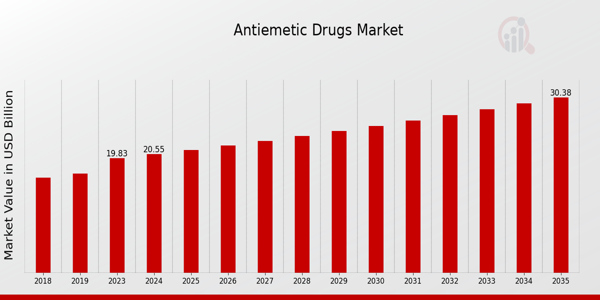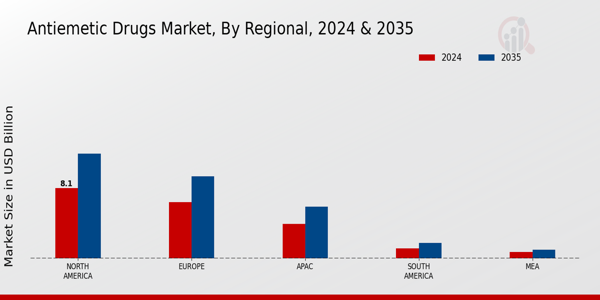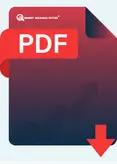Global Antiemetic Drugs Market Overview
As per MRFR analysis, the Antiemetic Drugs Market Size was estimated at 19.83 (USD Billion) in 2023.
The Antiemetic Drugs Market is expected to grow from 20.55(USD Billion) in 2024 to 30.4 (USD Billion) by 2035. The Antiemetic Drugs Market CAGR (growth rate) is expected to be around 3.62% during the forecast period (2025 - 2035).
Key Antiemetic Drugs Market Trends Highlighted
The antiemetic drugs market is witnessing significant growth driven by rising incidences of nausea and vomiting associated with various health conditions like cancer, pregnancy, and postoperative recovery. The growing awareness of healthcare and patient outcomes is prompting increased demand for effective antiemetic treatments.
Moreover, advancements in drug formulations and delivery systems have improved the efficacy and safety profiles of these medications, making them more appealing to healthcare providers and patients alike. As a result, producers are focusing on developing innovative solutions to better address the needs of diverse patient populations.Significant gaps exist in the antiemetic drugs market that can be immediately tackled, particularly in high-growth countries that have increasing healthcare coverage. Furthermore, expanding distribution networks and strategic alliances between pharmaceutical companies and healthcare providers can stimulate market growth. Moreover, the growing movement toward personalized medicine creates new opportunities for enhancing therapy adherence and treatment results. Another area of potential growth is the introduction of nonprescription antiemetic drugs for self-medication purposes.
There is recent evidence of shifting focus to prophylactic treatment of nausea and vomiting, particularly in cancer and postoperative patients.This proactive approach not only helps in managing symptoms but also improves the overall treatment experience. The integration of digital health technologies, such as mobile health applications that offer information about antiemetic use, is gaining popularity. Furthermore, a growing focus on lifestyle factors contributing to nausea is prompting research into natural remedies and dietary changes. With these developments, the global antiemetic drugs market is evolving to better meet the needs of patients, creating a landscape ripe for growth and innovation.

Source: Primary Research, Secondary Research, MRFR Database and Analyst Review
Antiemetic Drugs Market Drivers
Rising Incidence of Nausea and Vomiting Disorders
The Antiemetic Drugs Market is experiencing significant growth due to the rising incidence of various medical conditions associated with nausea and vomiting. Conditions such as chemotherapy-induced nausea, motion sickness, and postoperative nausea are prevalent, leading to increased demand for effective antiemetic medications. With advancements in healthcare and an increase in cancer treatments, the need for managing side effects like nausea is more critical than ever.As the patient population grows, particularly among the elderly and those undergoing complex medical treatments, the demand for antiemetic drugs is expected to rise. Furthermore, the growing awareness and prevalence of gastrointestinal disorders contribute to this surge, facilitating better diagnosis and treatment protocols. Healthcare professionals are actively seeking precise and effective antiemetic options to enhance patient comfort and treatment adherence.This need for effective management translates into a robust market for antiemetic drugs, fostering growth through continuous innovation and the introduction of new therapies. As the population continues to age and as lifestyles change, more individuals will likely experience health conditions that necessitate antiemetic interventions, driving further demand and expansion within the Antiemetic Drugs Market .
Advancements in Drug Formulations
Innovations in drug formulations are a key driver for the Antiemetic Drugs Market . The development of new antiemetic agents with improved efficacy and reduced side effects can significantly enhance patient adherence to treatment regimens. Novel delivery methods, such as transdermal patches and intravenous formulations, have broadened the accessibility of antiemetic therapies. These advancements facilitate the effective management of nausea and vomiting in various patient populations, including those undergoing chemotherapy and surgery.The continual research and development efforts in this sector contribute to a more robust pipeline of antiemetic drugs, supporting market growth.
Increasing Healthcare Expenditure
The increase in healthcare expenditures worldwide is fueling growth in the Antiemetic Drugs Market . As governments and private sectors allocate more funds to healthcare, the accessibility and availability of various medical treatments, including antiemetics, have improved. Higher healthcare spending allows for more advanced treatment options, leading to better management of nausea and vomiting conditions. This trend, combined with improved health insurance coverage, contributes positively to market expansion.Increased investment in healthcare infrastructure also encourages innovation, resulting in the development of more effective antiemetic drugs.
Antiemetic Drugs Market Segment Insights
Antiemetic Drugs Market Drug Type Insights
The Antiemetic Drugs Market exhibits a robust framework, showcasing diverse drug types that cater to various medical needs. In 2024, the market is poised for significant valuations, indicating a promising growth trajectory by 2035, where an overall market value of 30.4 USD Billion is anticipated. Within this sector, Drug Type segmentation reveals exciting dynamics among its constituents. Notably, Serotonin Antagonists hold a majority share, valued at 7.0 USD Billion in 2024 and expected to increase to 10.5 USD Billion by 2035, largely due to their effective role in managing chemotherapy-induced nausea and vomiting, making them a cornerstone in the antiemetic domain.Dopamine Antagonists follow with a valuation of 5.0 USD Billion in 2024, growing to 7.5 USD Billion in 2035, demonstrating their significance, particularly in treating post-operative nausea and nausea associated with various medical conditions, further emphasizing their importance in the global market landscape. Antihistamines, with a valuation of 4.5 USD Billion in 2024 and a projected increase to 6.0 USD Billion in 2035, are critical in addressing motion sickness and providing allergy-related relief, reflecting their dual application in both preventive and therapeutic capacities within the market.Glucocorticoids, although smaller in market share at 2.0 USD Billion in 2024, are expected to grow to 3.0 USD Billion by 2035. Their application in antiemetic treatment, particularly related to cancer therapies, underlines a niche yet essential role in therapeutic regimens. Lastly, Neurokinin-1 Antagonists, valued at 2.05 USD Billion in 2024 and projected to reach 3.4 USD Billion by 2035, are gaining traction for their specific efficacy against delayed chemotherapy-induced nausea and vomiting, indicating their rising importance in modern antiemetic therapy.Overall, the Drug Type segment within the Antiemetic Drugs Market encapsulates a diverse portfolio, each element playing a significant role in addressing patient needs and enhancing treatment outcomes in various clinical scenarios. The insights derived from the Antiemetic Drugs Market data highlight trends towards increased demand for these therapeutic agents, driven by rising incidences of nausea and underlying health conditions requiring effective management strategies, paving the way for opportunities in new product developments and advancements in drug formulations to cater to an evolving patient demographic for the Antiemetic Drugs Market .

Source: Primary Research, Secondary Research, MRFR Database and Analyst Review
Antiemetic Drugs Market Administration Route Insights
The Administration Route segment of the Antiemetic Drugs Market is essential for understanding how these medications are delivered to patients, significantly impacting their effectiveness and patient compliance. By 2024, the overall market is expected to reach a valuation of 20.55 USD Billion, showcasing the ongoing importance of antiemetic solutions in therapeutic treatments. The market segmentation reveals various methods, including Oral, Injectable, Transdermal, and Rectal, each playing a critical role in addressing nausea and vomiting associated with different medical conditions.The Oral route is particularly popular due to its ease of use and patient preference, while the Injectable method provides rapid relief, which is vital in acute care settings. Transdermal applications offer a convenient alternative for patients requiring sustained medication without frequent doses, thus enhancing adherence. Rectal administration remains essential for patients unable to take medications orally, ensuring that effective treatment reaches those in need. The dynamics in this segment reflect broader market growth driven by innovations in drug formulations and increased awareness of antiemetic therapies, although challenges such as adverse side effects and regulatory hurdles persist.The integration of technological advancements and patient-centered care presents new opportunities for expanding the market.
Antiemetic Drugs Market Therapeutic Area Insights
The Antiemetic Drugs Market is projected to reach a valuation of approximately 20.55 billion USD by 2024 and 30.4 billion USD by 2035, evidencing a consistent growth trajectory. Within the Therapeutic Area segment, the market reveals significant diversity, covering various conditions such as Nausea and Vomiting. Chemotherapy-Induced Nausea is particularly noteworthy, as it affects a large patient population undergoing cancer treatment, necessitating effective management strategies. Post-Operative Nausea is also crucial since it impacts patient recovery and hospital stays, emphasizing the importance of mitigating such effects to improve overall care.Additionally, Motion Sickness represents a prevalent challenge, notably affecting travelers and individuals in certain professions. These therapeutic areas collectively contribute to the overall Antiemetic Drugs Market revenue, showcasing a well-rounded approach to addressing various nausea and vomiting-related conditions. Adjacent to this, the Antiemetic Drugs Market statistics highlight ongoing trends, including increasing demand for new formulations and an emphasis on personalized medicine, leading to ample opportunities for innovation within the market.Additionally, growth drivers include rising awareness regarding antiemetic therapies and their growing acceptance among healthcare professionals, though challenges such as regulatory hurdles and high research costs remain in the industry's landscape.
Antiemetic Drugs Market End User Insights
The Antiemetic Drugs Market is expected to show significant growth, with a valuation of 20.55 USD Billion by 2024. The End User category, which includes key sectors such as hospitals, home care, specialty clinics, and ambulatory surgical centers, plays a crucial role in this market. Hospitals are major contributors, providing comprehensive treatment options and specialized care, thus dominating the market. Home care has gained traction due to the preference for at-home treatment, especially among patients experiencing nausea due to chemotherapy or post-operative conditions.Specialty clinics cater to specific medical needs, offering tailored antiemetic therapies that enhance patient outcomes. Ambulatory surgical centers are also significant, as they provide quick access to antiemetic drugs for patients undergoing same-day procedures. The market growth is driven by increasing healthcare expenditures, a rise in chronic illnesses, and growing awareness of effective antiemetic therapies. However, challenges such as regulatory hurdles and the cost of drug development may impact accessibility. With the anticipated increase in revenue, the Antiemetic Drugs Market data suggests a favorable outlook for these end-user segments as they adapt to evolving patient needs.
Antiemetic Drugs Market Regional Insights
The Antiemetic Drugs Market shows a diverse range of opportunities across its regional segmentation. In 2024, North America leads with a valuation of 8.1 USD Billion, reflecting a majority holding that underscores its significance in the market due to advanced healthcare infrastructure and high disposable income. Europe follows with a valuation of 6.5 USD Billion, indicating a robust presence driven by research and development efforts in pharmaceutical innovations. The APAC region, valued at 4.0 USD Billion in 2024, displays strong growth potential attributed to increasing healthcare access and rising awareness of antiemetic treatments.South America's valuation of 1.2 USD Billion reflects a growing market driven by an expanding population and healthcare investments, although its overall share remains small. Lastly, the MEA has a valuation of 0.75 USD Billion and is slowly gaining traction due to improving healthcare facilities and access to medications. The diverse dynamics of these regions create unique market growth opportunities, influenced by healthcare systems, demographics, and local regulations within the Antiemetic Drugs Market.

Source: Primary Research, Secondary Research, MRFR Database and Analyst Review
Antiemetic Drugs Market Key Players and Competitive Insights
The Antiemetic Drugs Market is a critical segment of the pharmaceutical industry, primarily dedicated to the development and distribution of medications designed to alleviate nausea and vomiting associated with various medical conditions, particularly in cancer therapy, motion sickness, and postoperative recovery. Competitive insights in this market reveal a landscape characterized by intense research and development, driven by the demand for more effective and targeted antiemetic therapies. Major players are constantly engaged in innovation to enhance drug efficacy, reduce side effects, and expand their therapeutic applications. The increasing incidence of conditions that trigger nausea, along with growing awareness of such issues, provides a strong impetus for market growth and competition among existing and emerging companies. Furthermore, strategic partnerships and collaborations among firms, coupled with a focus on regulatory approvals and market access, are key elements shaping competitive dynamics in this sector.Amgen stands out in the Antiemetic Drugs Market due to its robust research capabilities and significant investment in drug development. The company has established a formidable presence through its focus on innovative therapies that address severe nausea and vomiting, particularly those resulting from cancer treatments. Amgen's strength lies in its commitment to leveraging cutting-edge biotechnological research to develop effective antiemetic solutions. This commitment allows the company to cater to the specific therapeutic needs of patients undergoing challenging medical treatments, thereby solidifying its position in the competitive landscape. In addition, Amgen's extensive pipeline indicates a proactive approach to enhancing its therapeutic offerings, empowering healthcare providers with advanced tools to manage side effects associated with various interventions. The company's established infrastructure and dedication to patient-centric approaches further contribute to its competitiveness in the global market.Bristol-Myers Squibb has made notable contributions to the Antiemetic Drugs Market, focused on developing therapies that comprehensively address the needs of patients experiencing nausea and vomiting as a result of complex and severe medical conditions. The company is recognized for its innovative research and dedication to creating antiemetic medications with favorable safety profiles and improved outcomes. Bristol-Myers Squibb's strength resides in its comprehensive understanding of disease mechanisms alongside its commitment to thorough research and clinical studies that ensure the efficacy of its products. Through a strategic approach that includes collaborations and alliances within the healthcare sphere, Bristol-Myers Squibb enhances its ability to bring effective antiemetic solutions to the market. The firm's experience in oncology and its well-established relationships with healthcare professionals further position it as a reliable option in the competitive environment, helping to contribute to better patient experiences during difficult treatment periods.
Key Companies in the Antiemetic Drugs Market Include:
- Amgen
- Bristol-Myers Squibb
- Sanofi
- Mylan
- Johnson and Johnson
- Teva Pharmaceuticals
- Merck
- Eisai
- AbbVie
- GlaxoSmithKline
- Allergan
- Roche
- Purdue Pharma
- AstraZeneca
- Novartis
Antiemetic Drugs Market Developments
There have been several notable developments in the Antiemetic Drugs Market recently. Companies such as Amgen, Bristol-Myers Squibb, and Teva Pharmaceuticals continue to innovate and expand their product lines, with a strong focus on addressing unmet medical needs. Johnson & Johnson and AstraZeneca have been actively involved in collaborations to enhance treatment protocols, aiming for improved efficacy in nausea and vomiting management. Merger and acquisition activities have also stirred interest in this market segment, with large players like Sanofi and AbbVie exploring strategic partnerships to bolster their portfolios within the antiemetic domain. Increased funding and investment have led to a notable rise in market valuations for companies like Merck and Eisai, driven by an uptick in clinical trials and submissions for new drug applications. Such developments are indicative of the growing demand for effective antiemetic therapies as the prevalence of conditions requiring treatment rises, thereby impacting market dynamics significantly. Moreover, the ongoing focus on personalized medicine is likely to influence the future landscape of the antiemetic drugs market, driven by innovations from GlaxoSmithKline, Allergan, and Roche.
Antiemetic Drugs Market Segmentation Insights
- Antiemetic Drugs Market Drug Type Outlook
- Serotonin Antagonists
- Dopamine Antagonists
- Antihistamines
- Glucocorticoids
- Neurokinin-1 Antagonists
- Antiemetic Drugs Market Administration Route Outlook
- Oral
- Injectable
- Transdermal
- Rectal
- Antiemetic Drugs Market Therapeutic Area Outlook
- Nausea
- Vomiting
- Chemotherapy-Induced Nausea
- Post-Operative Nausea
- Motion Sickness
- Antiemetic Drugs Market End User Outlook
- Hospitals
- Home Care
- Specialty Clinics
- Ambulatory Surgical Centers
- Antiemetic Drugs Market Regional Outlook
- North America
- Europe
- South America
- Asia Pacific
- Middle East and Africa
| Attribute/Metric Source: |
Details |
| MARKET SIZE 2023 |
19.83(USD Billion) |
| MARKET SIZE 2024 |
20.55(USD Billion) |
| MARKET SIZE 2035 |
30.4(USD Billion) |
| COMPOUND ANNUAL GROWTH RATE (CAGR) |
3.62% (2025 - 2035) |
| REPORT COVERAGE |
Revenue Forecast, Competitive Landscape, Growth Factors, and Trends |
| BASE YEAR |
2024 |
| MARKET FORECAST PERIOD |
2025 - 2035 |
| HISTORICAL DATA |
2019 - 2024 |
| MARKET FORECAST UNITS |
USD Billion |
| KEY COMPANIES PROFILED |
Amgen, BristolMyers Squibb, Sanofi, Mylan, Johnson and Johnson, Teva Pharmaceuticals, Merck, Eisai, AbbVie, GlaxoSmithKline, Allergan, Roche, Purdue Pharma, AstraZeneca, Novartis |
| SEGMENTS COVERED |
Drug Type, Administration Route, Therapeutic Area, End User, Regional |
| KEY MARKET OPPORTUNITIES |
Rising prevalence of nausea disorders, Growth in cancer treatment therapies, Increasing demand for travel-related medications, Advances in drug formulation technologies, Expanding geriatric population needing support |
| KEY MARKET DYNAMICS |
Rising cancer cases, Increasing chemotherapy treatment, Growth in travel-related illnesses, Technological advancements in drug delivery, Aging population and healthcare access |
| COUNTRIES COVERED |
North America, Europe, APAC, South America, MEA |
Frequently Asked Questions (FAQ) :
The Global Antiemetic Drugs Market is expected to be valued at 20.55 USD Billion in 2024.
By 2035, the Global Antiemetic Drugs Market is projected to reach a value of 30.4 USD Billion.
The expected compound annual growth rate (CAGR) for the Global Antiemetic Drugs Market from 2025 to 2035 is 3.62%.
North America is expected to dominate the Global Antiemetic Drugs Market with a valuation of 8.1 USD Billion in 2024.
The market size for Serotonin Antagonists in the Global Antiemetic Drugs Market is valued at 7.0 USD Billion in 2024.
The Asia Pacific region is anticipated to grow to a market size of 6.0 USD Billion by 2035.
Key players in the Global Antiemetic Drugs Market include Amgen, BristolMyers Squibb, and Sanofi among others.
The market value for Dopamine Antagonists is projected to reach 7.5 USD Billion by 2035.
The Global Antiemetic Drugs Market faces challenges such as regulatory hurdles and competition among established drugs.
The market size for Glucocorticoids is expected to increase from 2.0 USD Billion in 2024 to 3.0 USD Billion in 2035.

















